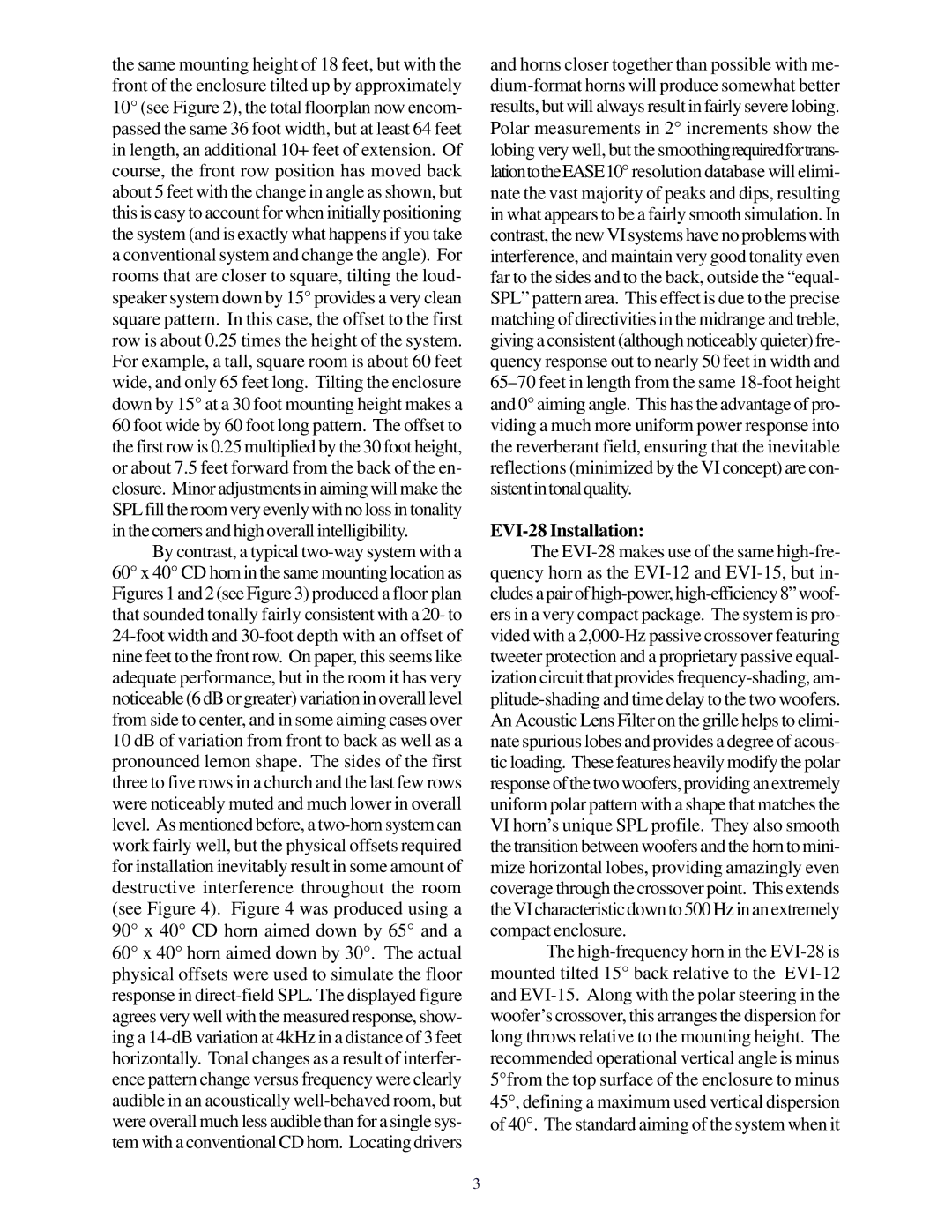the same mounting height of 18 feet, but with the front of the enclosure tilted up by approximately 10° (see Figure 2), the total floorplan now encom- passed the same 36 foot width, but at least 64 feet in length, an additional 10+ feet of extension. Of course, the front row position has moved back about 5 feet with the change in angle as shown, but this is easy to account for when initially positioning the system (and is exactly what happens if you take a conventional system and change the angle). For rooms that are closer to square, tilting the loud- speaker system down by 15° provides a very clean square pattern. In this case, the offset to the first row is about 0.25 times the height of the system. For example, a tall, square room is about 60 feet wide, and only 65 feet long. Tilting the enclosure down by 15° at a 30 foot mounting height makes a 60 foot wide by 60 foot long pattern. The offset to the first row is 0.25 multiplied by the 30 foot height, or about 7.5 feet forward from the back of the en- closure. Minor adjustments in aiming will make the SPL fill the room very evenly with no loss in tonality in the corners and high overall intelligibility.
By contrast, a typical two-way system with a 60° x 40° CD horn in the same mounting location as Figures 1 and 2 (see Figure 3) produced a floor plan that sounded tonally fairly consistent with a 20- to 24-foot width and 30-foot depth with an offset of nine feet to the front row. On paper, this seems like adequate performance, but in the room it has very noticeable (6 dB or greater) variation in overall level from side to center, and in some aiming cases over 10 dB of variation from front to back as well as a pronounced lemon shape. The sides of the first three to five rows in a church and the last few rows were noticeably muted and much lower in overall level. As mentioned before, a two-horn system can work fairly well, but the physical offsets required for installation inevitably result in some amount of destructive interference throughout the room (see Figure 4). Figure 4 was produced using a 90° x 40° CD horn aimed down by 65° and a 60° x 40° horn aimed down by 30°. The actual physical offsets were used to simulate the floor response in direct-field SPL. The displayed figure agrees very well with the measured response, show- ing a 14-dB variation at 4kHz in a distance of 3 feet horizontally. Tonal changes as a result of interfer- ence pattern change versus frequency were clearly audible in an acoustically well-behaved room, but were overall much less audible than for a single sys- tem with a conventional CD horn. Locating drivers
and horns closer together than possible with me- dium-format horns will produce somewhat better results, but will always result in fairly severe lobing. Polar measurements in 2° increments show the lobing very well, but the smoothingrequiredfortrans- lationtotheEASE10° resolution database will elimi- nate the vast majority of peaks and dips, resulting in what appears to be a fairly smooth simulation. In contrast, the new VI systems have no problems with interference, and maintain very good tonality even far to the sides and to the back, outside the “equal- SPL” pattern area. This effect is due to the precise matching of directivities in the midrange and treble, giving a consistent (although noticeably quieter) fre- quency response out to nearly 50 feet in width and 65–70 feet in length from the same 18-foot height and 0° aiming angle. This has the advantage of pro- viding a much more uniform power response into the reverberant field, ensuring that the inevitable reflections (minimized by the VI concept) are con- sistent in tonal quality.
EVI-28 Installation:
The EVI-28 makes use of the same high-fre- quency horn as the EVI-12 and EVI-15, but in- cludes a pair of high-power, high-efficiency 8” woof- ers in a very compact package. The system is pro- vided with a 2,000-Hz passive crossover featuring tweeter protection and a proprietary passive equal- ization circuit that provides frequency-shading, am- plitude-shading and time delay to the two woofers. An Acoustic Lens Filter on the grille helps to elimi- nate spurious lobes and provides a degree of acous- tic loading. These features heavily modify the polar response of the two woofers, providing an extremely uniform polar pattern with a shape that matches the VI horn’s unique SPL profile. They also smooth the transition between woofers and the horn to mini- mize horizontal lobes, providing amazingly even coverage through the crossover point. This extends the VI characteristic down to 500 Hz in an extremely compact enclosure.
The high-frequency horn in the EVI-28 is mounted tilted 15° back relative to the EVI-12 and EVI-15. Along with the polar steering in the woofer’s crossover, this arranges the dispersion for long throws relative to the mounting height. The recommended operational vertical angle is minus 5°from the top surface of the enclosure to minus 45°, defining a maximum used vertical dispersion of 40°. The standard aiming of the system when it
